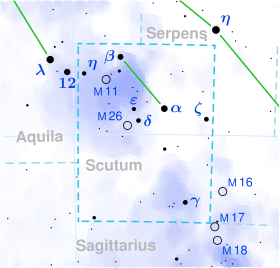R Scuti
| Observation data Epoch J2000 Equinox J2000 | |
|---|---|
| Constellation | Scutum |
| Right ascension | 18h 47m 28.95s[1] |
| Declination | −05° 42′ 18.5″[1] |
| Apparent magnitude (V) | 4.2–8.6[2] |
| Characteristics | |
| Evolutionary stage | Asymptotic giant branch[3] |
| Spectral type | G0Iae-K2p(M3)Ibe[4] |
| U−B color index | 1.53[5] |
| B−V color index | 1.47[5] |
| Variable type | RV Tau[2] |
| Absolute magnitude (MV) | ~ −2 – −3[8] |
| Details | |
dex | |
AAVSO 1842-05 | |
| Database references | |
| SIMBAD | data |
R Scuti (R Sct) is a star in the
Observation
R Sct is the brightest of the RV Tau-type stars[12] and the American Association of Variable Star Observers (AAVSO) contains over 110,000 observations of this star.[13] At its brightest it is visible to the naked eye, and at its dimmest can be located with good binoculars.[13] In the sky it is about 1 degree northwest of the Wild Duck Cluster (Messier 11).[13]
RV Tauri variables often have somewhat irregular light curves, both in amplitude and period, but R Scuti is extreme. It has one of the longest periods known for an RV Tau variable, and the light curve has a number of unusual features: occasional extreme minima; intermittent standstills with only small erratic variation that may last for years; and periods of chaotic brightness changes.[14][15]

Properties
The spectrum of R Scuti is peculiar, especially at cooler temperatures near the minima. In deep minima, much of the spectrum corresponds to an early K supergiant, but the spectrum also develops TiO bands more typical of an M-class star.[16]
The recognised spectral type of G0Iae-K2p(M3)Ibe gives an idea of the complexities of this star. Both the radius and temperature change, with maximum brightness corresponding to maximum temperature. The radius changes lag and the smallest size occurs about a quarter of the period after the minimum brightness.[4]
The spectral luminosity type classes R Sct as a supergiant, a
An extreme post-AGB star would be expected to show measurable secular changes in its temperature and period over the time that R Scuti has been closely observed. Instead a relatively low mass loss rate with an extended cool atmosphere and fairly constant temperature and period of variation is seen. One suggestion is that R Scuti is still a thermally pulsing AGB star, consistent with calculated levels of mass loss.[9]
The evolutionary status of R Scuti is uncertain and estimates of the mass vary wildly. RV Tau variables as post-AGB stars are expected to have masses near or below that of the sun and this is confirmed for a number of RV Tau stars in binary systems.[17] Old estimates based simply on the supergiant luminosity class gave much higher masses.[18]
See also
References
- ^ S2CID 18759600.
- ^ a b "GCVS Query=R Sct". General Catalogue of Variable Stars @ Sternberg Astronomical Institute, Moscow, Russia. Retrieved 2010-11-24.
- ^ S2CID 16131273. A18.
- ^ Bibcode:1994A&A...287..866S.
- ^ Bibcode:2002yCat.2237....0D.
- S2CID 119231169.
- ^ .
- ^ .
- ^ S2CID 119342312.
- ^ S2CID 54547984.
- S2CID 186214528.
- ^ "GCVS Type=RV". General Catalogue of Variable Stars @ Sternberg Astronomical Institute, Moscow, Russia. Retrieved 2010-11-24.
- ^ a b c "R Scuti : A Favorite Among Its Class". AAVSO. Retrieved 2010-11-24.
- Bibcode:1991A&A...246..490L.
- Bibcode:1992A&A...259..215G.
- JSTOR 40678238.
- doi:10.1086/115190.
- ISBN 0486318036.
External links
- AAVSO: Quick Look View of AAVSO Observations (get recent magnitude estimates for R Sct)

